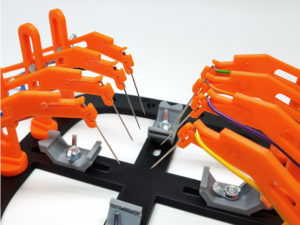 One Italian police officer is very no-nonsense about his job—as many are—but he’s even more so as a maker. Searching for greater efficiency while working in the lab, Giuseppe Finizia has created a new iteration of his PCB workstation, putting the power of 3D printing further to work. We followed his original project a couple of years ago, as he brought forth a PCB workstation with articulated arms, all in an attempt (quite a successful one) to perform technical assessments more fluidly.
One Italian police officer is very no-nonsense about his job—as many are—but he’s even more so as a maker. Searching for greater efficiency while working in the lab, Giuseppe Finizia has created a new iteration of his PCB workstation, putting the power of 3D printing further to work. We followed his original project a couple of years ago, as he brought forth a PCB workstation with articulated arms, all in an attempt (quite a successful one) to perform technical assessments more fluidly.
Finizia works in the Scientific Investigations Department of the Carabinieri—Italian military police—and spends most of his time in the electronics library. For his original work, he used the MoI 3D to make the 3D printed parts. Fast forward a couple of years and he is now using a Zortrax M200 to create and refine his innovations.
“In this new design, I have swapped out the Hirschmann spring loaded test probes that were used in the previous model for standard sewing needles, which has drastically reduced the cost of parts for the PCB workstation,” Finizia told 3DPrint.com. “Moreover, I have added an elastic pressure mechanism to each crane arm, which adequately ensures the connection between the tip of the needle and the circuit board. The 3D printed crane arms have been modified to be thinner and less bulky, which frees up considerable workspace space for user.
“Finally, the new version’s base frame is compatible with various types of articulated arms and accessories, including the ones that were designed for the first PCB workstation.”
Featured on Thingiverse, this new project is clearly an ‘evolution’ of his previous work, with the following new features:
- Less expensive probes. Finizia has now been able to 3D print cheaper sewing needles that also allow for ‘very precise connections.’
- Use of numerous accessories from Finizia’s first piece of work, with the frame being able to use multiple articulated arms at the same time, whether of crane or ball and socket type.
- Less cumbersome crane arms. Compared to the previous workstation, they allow more space for the user to work.
 Users who are interested in such a workstation can check out the design and instructions on Thingiverse should they wish to 3D print their own. Post-printing procedures are listed as well and are fairly simple, including advice on how to mount the bumpers for more stability, and then begin assembling the PCB holders and articulated arms. Finizia recommends a couple of different needle sizes that can be used, along with additional parts and accessories such as a magnifying glass, LED lamp, or more. Finizia suggests checking out his previous edition for more accessory ideas. Discuss in the 3D Printed Workstation forum at 3DPB.com.
Users who are interested in such a workstation can check out the design and instructions on Thingiverse should they wish to 3D print their own. Post-printing procedures are listed as well and are fairly simple, including advice on how to mount the bumpers for more stability, and then begin assembling the PCB holders and articulated arms. Finizia recommends a couple of different needle sizes that can be used, along with additional parts and accessories such as a magnifying glass, LED lamp, or more. Finizia suggests checking out his previous edition for more accessory ideas. Discuss in the 3D Printed Workstation forum at 3DPB.com.
Subscribe to Our Email Newsletter
Stay up-to-date on all the latest news from the 3D printing industry and receive information and offers from third party vendors.
You May Also Like
Profiling a Construction 3D Printing Pioneer: US Army Corps of Engineers’ Megan Kreiger
The world of construction 3D printing is still so new that the true experts can probably be counted on two hands. Among them is Megan Kreiger, Portfolio Manager of Additive...
US Army Corps of Engineers Taps Lincoln Electric & Eaton for Largest 3D Printed US Civil Works Part
The Soo Locks sit on the US-Canadian border, enabling maritime travel between Lake Superior and Lake Huron, from which ships can reach the rest of the Great Lakes. Crafts carrying...
Construction 3D Printing CEO Reflects on Being Female in Construction
Natalie Wadley, CEO of ChangeMaker3D, could hear the words of her daughter sitting next to her resounding in her head. “Mum, MUM, you’ve won!” Wadley had just won the prestigious...
1Print to Commercialize 3D Printed Coastal Resilience Solutions
1Print, a company that specializes in deploying additive construction (AC) for infrastructure projects, has entered an agreement with the University of Miami (UM) to accelerate commercialization of the SEAHIVE shoreline...































